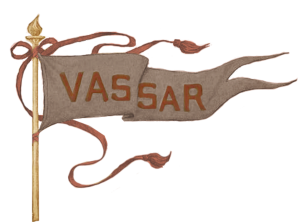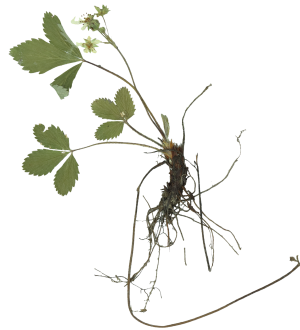1874 - 1968
Miss Gertrude Smith was born in Portland, Maine, on June 5,
1874, a daughter of Manasseh and Georgiana Hall Smith. She
died at Portland on April 9, 1968.
When Gertrude Smith entered Vassar College as a freshman with
the class of 1897, she had bright auburn hair, observant blue
eyes, a vigorous joy in life, and an impressionable keen mind.
During the four years preceding her graduation as a Phi Beta
Kappa member with a major in mathematics, she had developed not
only the keen mind, but also an intense loyalty to her college
and its ideals. After a few years of teaching in Portland,
followed by a year at Miss Gerrish's school in Englewood, New
Jersey, where she taught mathematics, English and Greek, she
returned happily to Vassar to study for a Master of Arts degree.
Following its award in 1901, she became instructor in mathe-
matics, and thus entered upon an association with the college
that continued until December, 1944, without interruption
except for the year of l907—'08. That year she spent in further
graduate study at Cornell University and at the Sorbonne. In
Paris she studied under a fellowship granted by the Associate
Alumnae of Vassar College.
Beginning in 1909, Miss Smith became head resident of Davison
House, a post in which she continued until her retirement
thirty-five years later. She was also Associate Warden of the
college from 1913 to 1932. In these positions, she came in
contact with hundreds of students besides those whom she taught
in her numerous mathematics classes. Each of these students
was to Gertrude Smith a very important person. Her interest
in their development was candid, penetrating and patient. In
later years people recalled the patience with which she guided
the slower ones in class; in her younger years, she was known
at times to let her red-haired impatience with stupidity give
way to the extent of throwing the chalk at a laggard student.
Quietly and constantly industrious herself, she never condoned
laziness. Yet she was always ready to confer when her help or
advice was sought in the friendly apartment at Davison. The
students reciprocated with loyalty to match her devotion to them.
No promotion ever made her happier than her election to be the
honorary faculty member of the class of 1916. From that time,
the members of this class became her particular Vassar family.
She knew them one and all, and received them eagerly at reunion
times. Some of them became close personal friends for her life-
time. Her associations were equally warm with her own class.
GERTRUDE SMITH continued.
After her retirement she served for twenty—one years as
editor of the annual bulletin of the class of 1897. In
January, 1966, she wrote with pride: "We are the only
class which has sent out an annual bulletin for sixty-five
years."
Two nieces of Miss Smith graduated from Vassar; one Miss
Katharine Ogden, class of 1918, was a former member of the
Vassar chemistry faculty. Her sister, Miss Ruth Patterson
Ogden, graduated in 1934.
For an extended period, Miss Smith's association with Vassar's
department of mathematics was contemporary with the chairman-
ship of the distinguished geometer, Professor H. S. White.
Later, she became the right-hand partner of Professor Mary
E. Wells. For years, Miss Smith taught a course in the
analytic geometry of three dimensions that long remained a
cornerstone of the mathematics major program. She became
assistant professor in 1919, associate professor in 1936,
and was made a full professor in 1943. She was a member of
the American Mathematical Society, and in 1938 was made a
fellow of the American Association for the Advancement of
Science. For twenty-five years she served as a reader for
the college entrance examination board. A promoter of high
academic standards, she was a staunch member of the Vassar
chapter of Phi Beta Kappa, and served one year as its president.
Her earliest teaching experience had included classes in Latin
and Greek. She maintained an interest in Greek archaeology which
was fostered by her friendships with several archaeologists
among Vassar alumnae families. But her own creative ability
was most apparent in her considerable talent for drawing and
painting, largely self-developed. Subjects for her charming
small line-drawings were usually glimpses of the Vassar campus,
often in the vicinity of one of the lakes. For two or three
years, she regularly attended an evening class conducted by
Professor Clarence Chatterton, where some fourteen faculty
members followed his instruction in drawing from life, and then
reviewed their efforts in serious self-criticism.
Miss Smith was intensely interested in all political develop-
ments, national and international. And she did not hesitate
to express an opinion. Her travels included many trips to
England and Scotland, and a memorable visit to Greece and Italy,
GERTRUDE SMITH continued
with briefer sojourns in other European countries. Each of
these trips, as well as a trip after retirement to California
became a journey of discovery. Always sensitive to beauty,
she followed up her discoveries with enthusiasm, whether for
the beauties of nature or for those of group theory or
geometry.
For as long as health permitted, she traveled from Maine to
Poughkeepsie to spend a few weeks each year at Alumnae House.
And each year, scores of former students and associates stopped
to see their remarkable friend at the Sheraton-Eastland Hotel,
where she made her home in retirement, at Portland.
In 1962, the department of mathematics set up the Mary E. Wells
and Gertrude Smith prize fund, with awards to be made for
excellence in the study of mathematics. This honor brought
real joy to Miss Smith.
An outside opinion is often valuable, and we have one from an
American scholar, the late professor Marie J. Weiss, herself
a distinguished research mathematician, who taught at Vassar
in the nineteen thirties. She declared, "Miss Smith may not
be a research mathematician, but she is a superb teacher."
This is how Gertrude Smith, loyal daughter of Vassar, would
have liked to be remembered. To quote her own admonition from
the 1916 Vassarion: "May your torch burn ever bright".
Respectfully submitted, for all
the friends of Gertrude Smith, by
Frances E. Baker
XVIII 333-334

